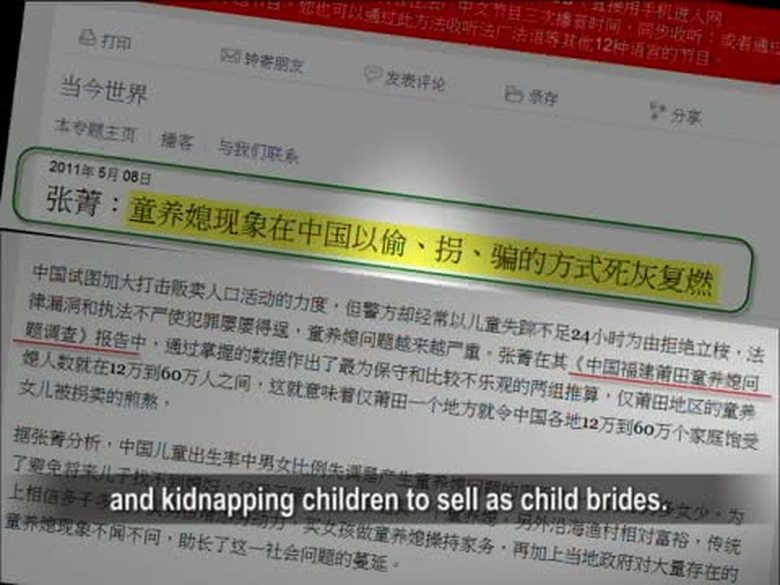【新唐人2011年5月10日訊】近日媒體報導,全中國有將近六千萬的留守兒童,有的還沒滿週歲,父母就離家打工。寫作《中國在梁莊》一書的作者梁鴻的形容是:村莊沒人了,老房子拆掉,土地荒掉,父母跟孩子分離變正常狀態,數千萬留守兒童的未來令人擔心。
本月初,台灣《亞洲週刊》報導,2009年中國婦聯會統計,全中國有五千八百萬的留守兒童,現在已逼近六千萬人。他們是二億五千萬的農民工留在家鄉的孩子。有的還沒滿週歲,父母就離家打工,只跟爺爺奶奶生活。有的還沒學會自理就要進寄宿學校。
報導指出,2005年中國修訂《義務教育法》,加大農村教育投入,2007年「兩免一補」全面落實到農村。表面上看起來,農村入學率一直在提升。不過常年關注鄉村教育的社會工作者梁曉燕卻發現:有些數字是不統計的,比如文盲率下降,但返盲率很高。入學率達到百分之99,但輟學率也很高。
2007年梁曉燕曾在廣西一所鄉村小學支教一年,她看到一年級56個孩子,四年級剩31個,到六年級只剩16個。她跟附近五所學校的校長還不熟的時候,校長們都說他們的輟學率是百分之三。後來大家熟了,他們才說出這些小學的輟學率都超過百分之50。但這些從來不會被統計上去。
此外,為了整合資源,官方近年來推行「撤點並校」,大量撤掉村一級學校,並且在縣鎮一級大量推行寄宿制學校。
不過梁曉燕發現:很多學校還沒蓋好,基層學校就撤了。十幾個學校的學生全集中過來,老師不夠,教室也不夠,一間教室常擠著七、八十個學生。二十四小時住校,孩子常出現心理問題。第一次去農村志願支教的大學生常問:這些孩子為甚麼這麼不懂事?這麼壞?他們傷心,梁曉燕也很傷心。
1998年到2007年間,全國適齡兒童人數減少百分之24,但學校總數卻減少百分之47,比人口減少大了一倍。大量撤掉基層學校的結果是,許多孩子連上學都有困難。
寫作《中國在梁莊》一書的作者梁鴻的形容是,梁莊小學關閉後,接送孩子上學的老人每天都得把孩子送到鎮上,早、中、晚都要接送,每天來回六趟,一趟二里地。
而許多孩子才一歲,父母就出去打工,爺爺奶奶帶到五六歲上學,直到初中上寄宿學校。梁鴻發現,留守兒童變得封閉、冷漠、自卑、孤僻。比如梁莊所隸屬的河南省穰縣,從2007年到2009年,留守青少年的犯罪案件增加了一倍,犯罪人數更增加了三倍多。
梁曉燕還發現:現在官方對農村老師的評審標準就是看考試成績,比城市更追求升學率。她表示,教育只為了升學,學校只是趕著你去考試。很可怕!
《亞洲週刊》質疑,幾億農民工的下一代從小遠離父母,教育只為了考試,上大學的機率卻不到一成,他們的未來在哪裏?
新唐人記者曾耀賢、王明宇綜合報導。
60 Million Children Left Behind
In rural China, nearly 60 million children
are left behind when their parents migrate
to urban areas to find work.
According to author Liang Hong: “Villages are empty,
houses are torn down and farmland is abandoned.
Its normal for children to be split from parents.”
According to Asia Weekly, statistics released
by All-China Women's Federation show that in 2009,
58 million children were left-behind,
the number must be closer to 60 million today.
Children of the 250 million migrant workers
were left with grandparents before the age of one,
or sent to boarding school at very young ages.
Revision of the Compulsory Education Law in 2005
increased the education budget in rural areas.
On the surface school enrollment rate has increased
in rural areas; but according to social worker
Liang Xiaoyan, the statistics are not comprehensive.
For example, although illiteracy rate is lowering,
the rate of returning to illiteracy is high;
although school enrollment rate reached 99%,
school dropout rate remains high.
In 2007, Liang taught in a rural school in Guangxi,
where she saw 51 students in the first grade
drop to 31 students in the fourth grade,
further dropping to 16 in the sixth grade.
Principles of the 5 nearby schools
claimed that their dropout rate was 3%.
Liang later found that rate to be in fact over 50%.
Moreover, in recent years, schools are being merged
for resources consolidation purposes.
Village schools are closed
and boarding schools are opened in townships.
Liang Xiaoyan discovered that village schools
were closed before the constructions
of boarding schools were finished.
There were not enough teachers or classrooms,
many students also suffered psychological issues.
New teachers now constantly ask why students
behave so bad. This situation saddens everyone.
From 1998 to 2007 the number of school-age children
in China decreased 24%, while the number of schools
decreased by 47%. As a result, many children
face difficulties with school enrollments.
According to author Liang Hong,
after village schools were closed, the elderly
had to take the children to the township
3 times a day. A 2km roundtrip each time.
Many children were left behind before turning one,
they lived with grandparents until boarding school.
Withdrawn and unsociable, such children contribute
to the dramatic increase in adolescent delinquency.
Liang Xiaoyan found that teachers were evaluated
based on students』 test scores alone.
College admission became the push toward education,
a very dangerous state according to Liang.
Asia Weekly asks: ”With the college admission rate
less than 1%, what will be the future
of these left-behind children?”
NTD reporters Zeng Yaoxian and Wang Mingyu
看下一集

【禁聞】“龍顏大悅”新曲 惡搞“五道槓”

【禁聞】《紐時》社論剛發 律師現身說法

【禁聞】官員享受特供菜 百姓憂心盤中餐

【禁聞】童養媳復燃 計生官員搶嬰外銷

【禁聞論壇】籌款須知?

【禁聞】美中對話 中共怕國內抗議 望低調

【禁聞】網友炮製「中國特色」有毒食品國宴

【禁聞】曬“公共安全賬”《財經》助《法廣》?

【禁聞】800多名學生被“光明正大”欺騙

【禁聞】許宗衡被判死緩 貪賄額縮水涉內鬥

【禁聞】中國4月通脹略有回降但壓力仍巨

【禁聞】老作家諫言胡錦濤 被軟禁

【禁聞】“選對人” 賈慶林施壓台灣選舉

【禁聞】美方批人權 中方打太極

【禁聞】計生官員“沒收”嬰兒出口

【禁聞】汶川地震三週年 學校重建的真相








